
After an overnight drive through the mountain ranges interspersed with deep gorges and valleys of Himachal Pradesh, the HRTC Himani finally reached Reckong Peo bus stand at 7:00 am. It is that time of the year when this part of the Kinnaur region is covered with a thick blanket of snow. But to everyone’s amazement the sky remained pretty clear with no chances of precipitation. The cold wind seeped into our bones as we grappled with our luggage to find a warm corner in a new town. With a slurred speech caused by shivering in the cold, I expressed to the co-passenger that my mobile had lost its network and if I could borrow his phone to make a call to our host.
Sipping hot tea under the roof of a tin shop, we impatiently waited for Mr. Amit Negi. It was a long, exhausting journey from Mumbai to Reckong Peo. To wake up and find yourself in a new place is what makes travellers happy. But rest was the need of the hour and we too longed for it.
HOW KALPA WAS PLANNED
Once a year we do a trip to North India. We have travelled to places like Manali, Shimla, Dharamshala, Dalhousie in Himachal Pradesh and Mussoorie & Landour in Uttarakhand. From the year 2021, we have been pursuing snowfall but were unfortunate to witness it. So this time around we decided on Kalpa, which is known as a winter wonderland for snow lovers.
Thus buying and packing all the essential winter wear, we were prepared and excited to experience our first snowfall. We dreamed of playing in the snow and making the perfect snow angel. And shaking the dust of snow from the deodar trees. We mentally prepared ourselves for the 28 hour train journey from Mumbai to Chandigarh and then the 14 hour bus journey from Chandigarh to Reckong Peo.
A long train journey can either make or spoil your mood. It also depends on the kind of passengers you share your berth with. We had to adjust ourselves with an irritating and non-cooperative family and bear their tantrums just because we did not exchange seats as per their wish. There was a moment where we had two options – either be silent or be violent. We chose the first one and patiently waited till they got down at Mathura. A big sigh of relief.

We reached the Chandigarh bus stand just 5 minutes before the departure time of 05:50 pm. The trunk of the semi-deluxe bus was full and had no space for our two trolley bags. Adjusting one near the cabin and one in the passage we took our seats. As the bus moved through the roads of Chandigarh and took the national highway (NH-5) towards Shimla, my thoughts meandered to Kalpa imagining how it would be when we reached in the morning.
Although the weather forecast showed no indication of snowfall, we had hopes on Kalpa that it would not disappoint us in the next 8 days of our stay.
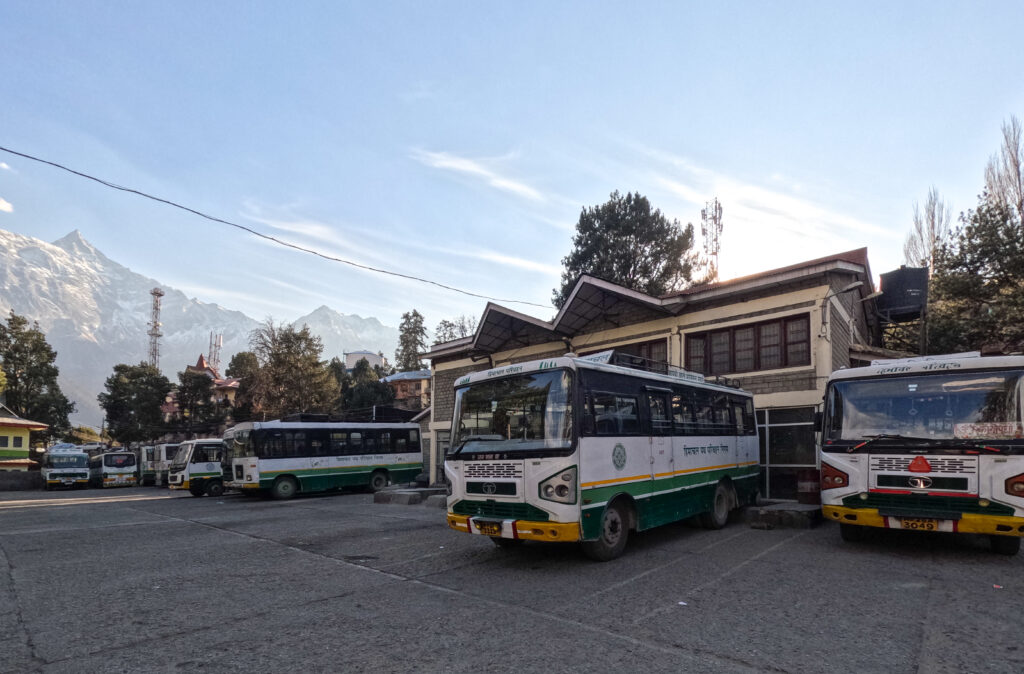

A HOME ON THE RANGE- AMONGST DEODAR & PINE FOREST
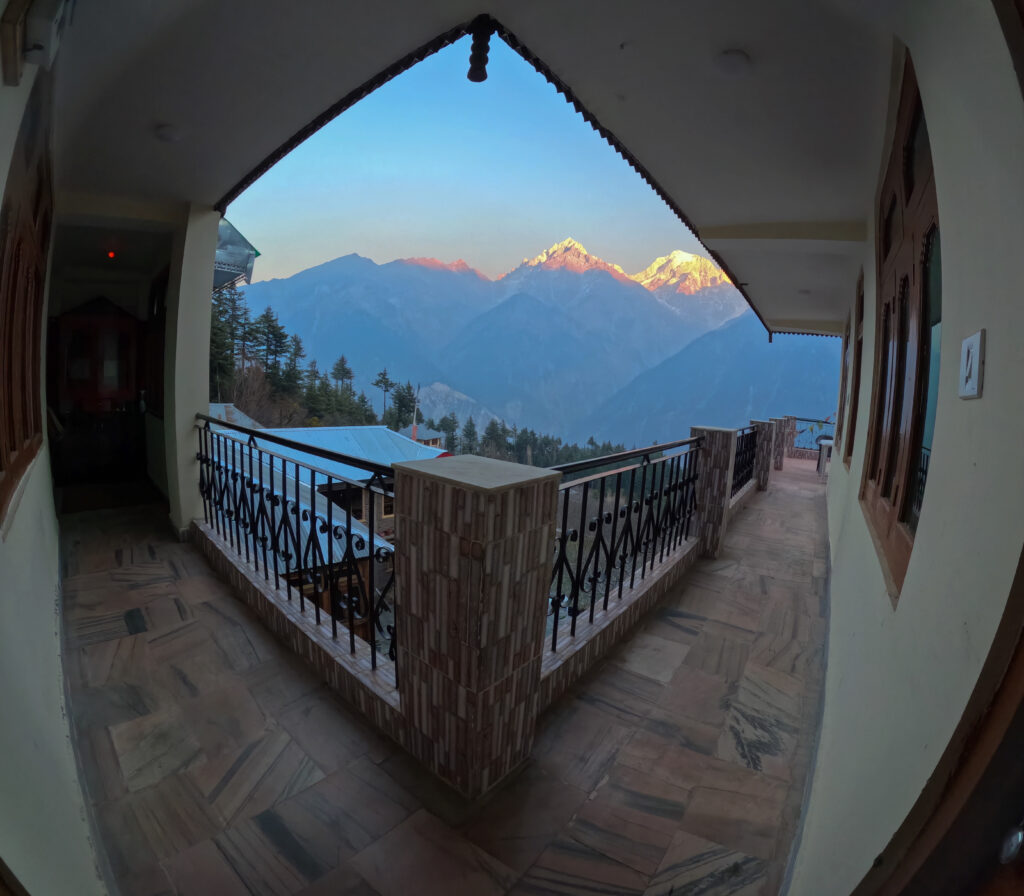
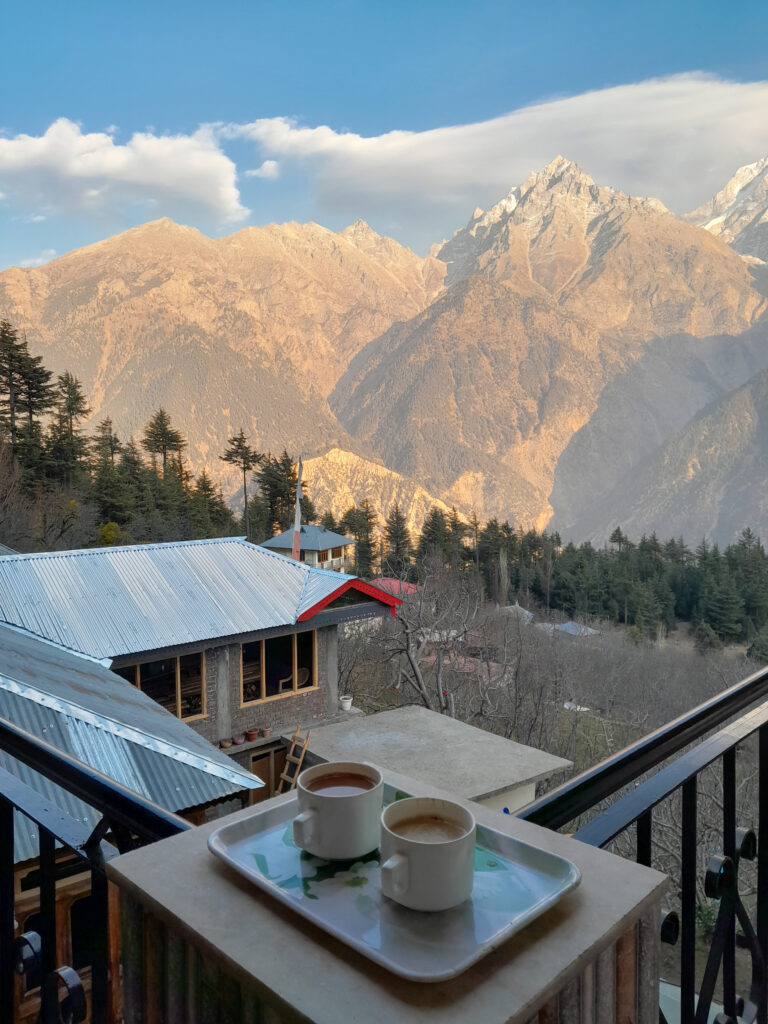
It was very kind of Mr. Negi that he came to receive us early in the morning. Our stay was at the ‘Aaruhee Homestay’ on the lower slopes of Kalpa. The car began climbing the road. The white mountains were in the view whenever the car took a winding turn uphill. I recalled my conversation with him a month ago when the homestay was being booked. At first he was reluctant to give accommodation to us during winters as it gets exceedingly cold. From January to February none of the hotels or homestays operate in Kalpa. During snowfall it becomes difficult to manage due to water issues. But somehow I was able to convince him that we are travellers and wouldn’t mind experiencing a little discomfort. And our purpose was to experience our first snowfall. We were more interested in gaining some experience and getting a feel of how it is to live like a local.
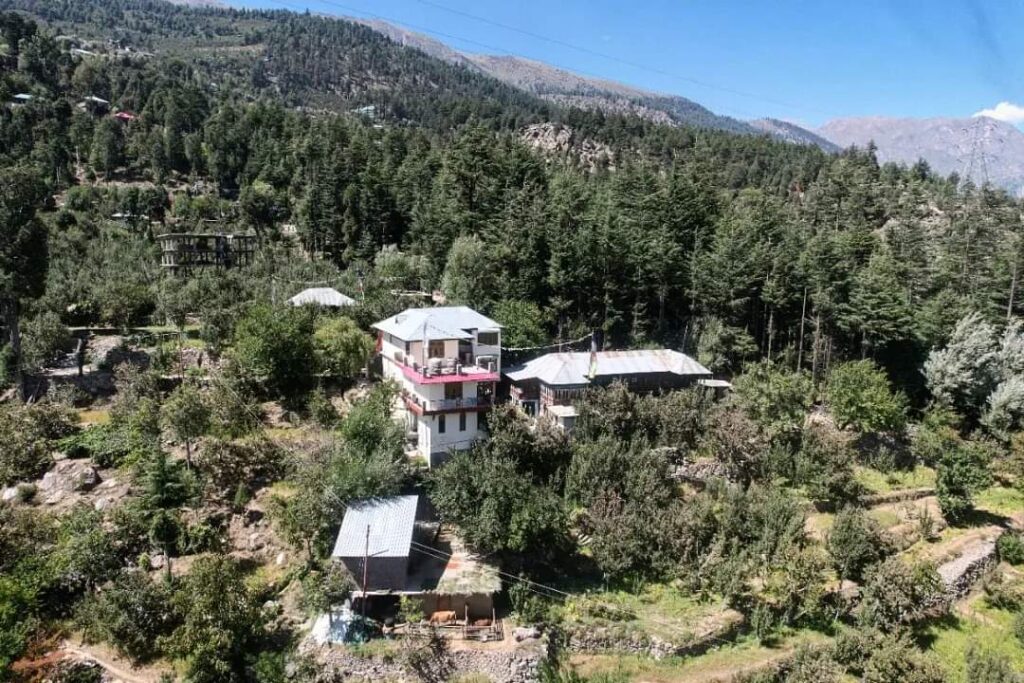
Just as we are very particular about selecting a stay which is undisturbed, silent and surrounded by nature; so is Mr. Negi about hosting guests. He is not a money minded man but a gentleman believing in peace of mind. He does not like to host people who are noisy and boisterous. To avoid the disturbance to the serenity of the place, he only accepts guests one at a time.
As the gate was opened, his two pet dogs – Lufy & Tufy came running. They were aggressive initially but we quickly made friends with them. And over the days they followed us wherever we went and sat beside us wherever we did to soak in some sunshine. They had a role to play in protecting the apple orchard from the monkeys. Both of them are doing a fantastic job, claims Mr. Negi, commanding Lufy to sit who is more jolly and mischievous. Tufy is a silent old chap. But very sharp and reacts only when required.
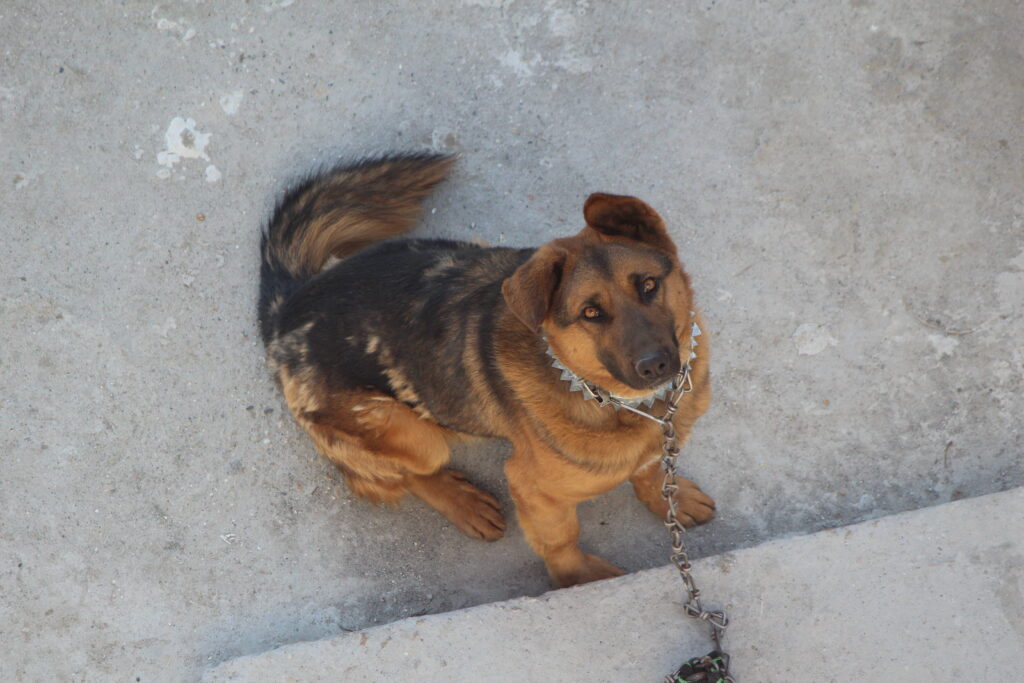
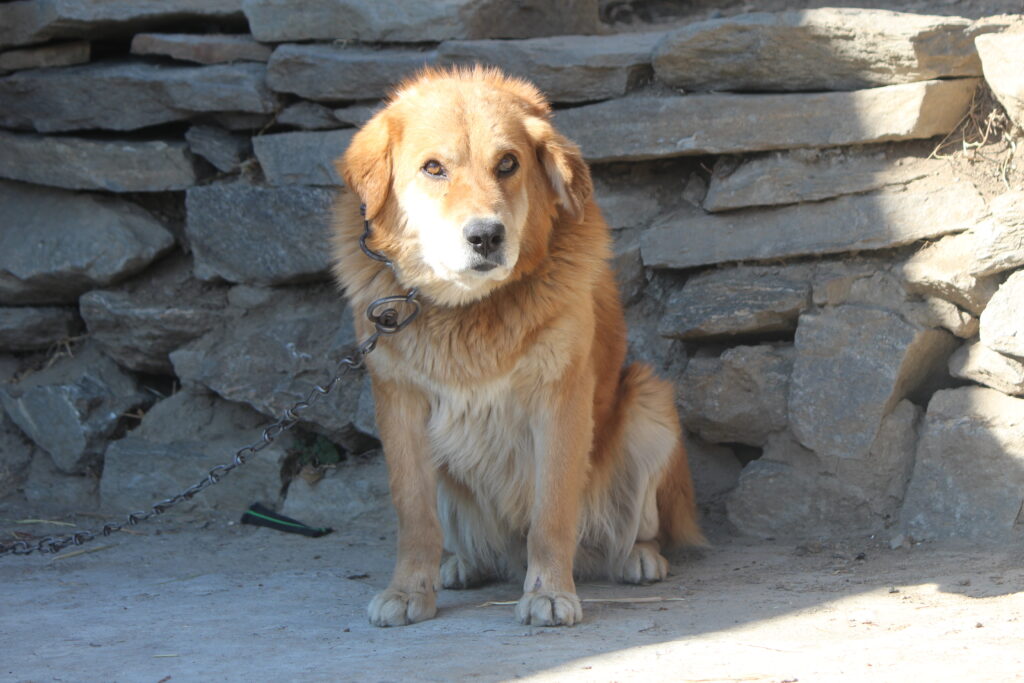

The view of the snow capped mountain is amazing from the homestay which is surrounded by the deodar and pine forest. There are apple orchards everywhere. Though the apple trees were barren with no leaves and fruits, their presence still gave a good feeling. They were being pruned to remove dead branches to balance growth and fruit production. Winter is a key time for pruning trees to keep them healthy, says Mr. Negi, offering us a cup of coffee.
The host family is well educated and experienced in farming. After working for 10 years in the field of animation in Delhi, Mr. Negi, now into his thirties, returned back to his home in Himachal to completely focus on farming. He does not like the fast paced life in the plains and finds contentment in doing what he loves. He understands the apple trees and how they respond to the weather conditions. According to him the apple crop is sensitive to its growing conditions and snowfall and low temperatures are the key factors for a good harvest. Snowfall helps the trees in many ways. The trees waited for the snow and so did we.
The distant peak (shivling) of Kinner Kailash located at a height of 19,850 feet can be clearly seen from the homestay. The shivling is known as the abode of Lord Shiva & Goddess Parvati. It is one of the most important and deeply revered peaks by the Hindus. The 14 km long and tough trek to the peak is a rigorous and steep climb.
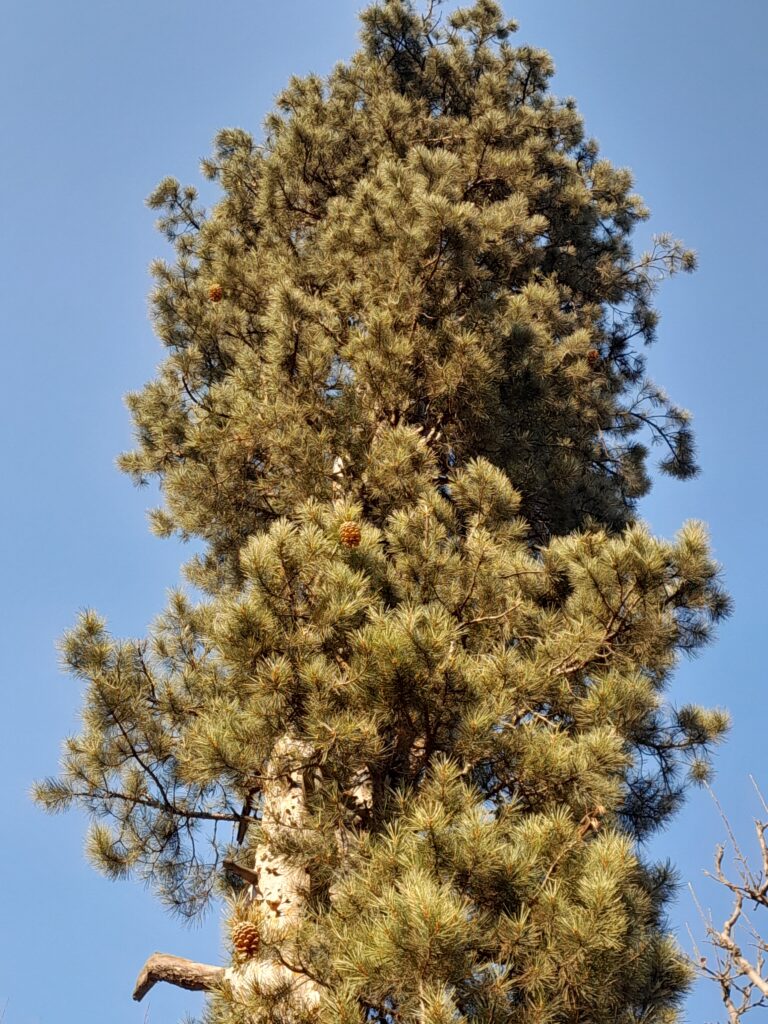
It is worth going for a walk among the trees. On one such walk we came across a woman mixing manure to the soils in the apple orchard while her little girl played around. She introduced us to the wonder tree of Kinnaur – ‘The Chilgoza Tree’ (Pinus Gerardiana). The tree stood erect with open crowns and needle-like leaves. The pine cones clung onto the tree. Removing the nuts from the cones is an extremely difficult process. Once done they are roasted on a pan and eaten by peeling the shell of the nut.


The nights were extremely cold with temperature dipping below -7 degrees. After dinner, we yearned for a bit of a stroll around to watch the sky on a clear dark night but the cold wind kept us almost entirely indoors. It was extremely important we dressed up in proper layers.
The sun lingered behind and took time to rise above the tall mountain. And when it’s sunshine fell on the house at nine o’clock in the morning, we would run out on the terrace to soak in the yellow dazzling sunlight to beat the cold. But it would only last until 4 pm and the sun would hide behind the upper slopes and the tall trees wouldn’t allow the sunlight to fall on the house. But the rays of the melting sun would fall on the snow capped peaks illuminating the mountains and that made for a scenic and pleasing sight.
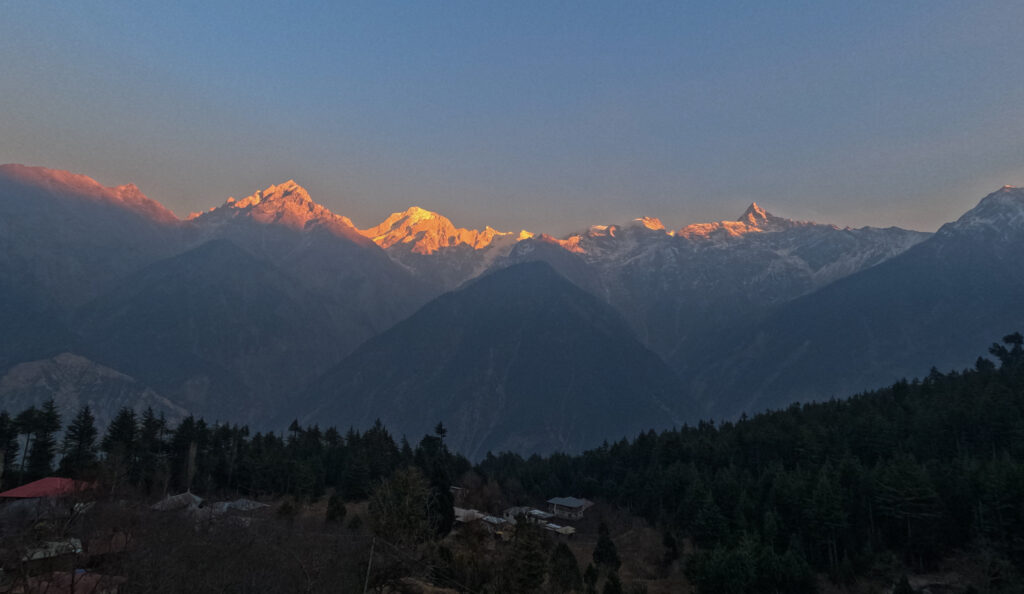

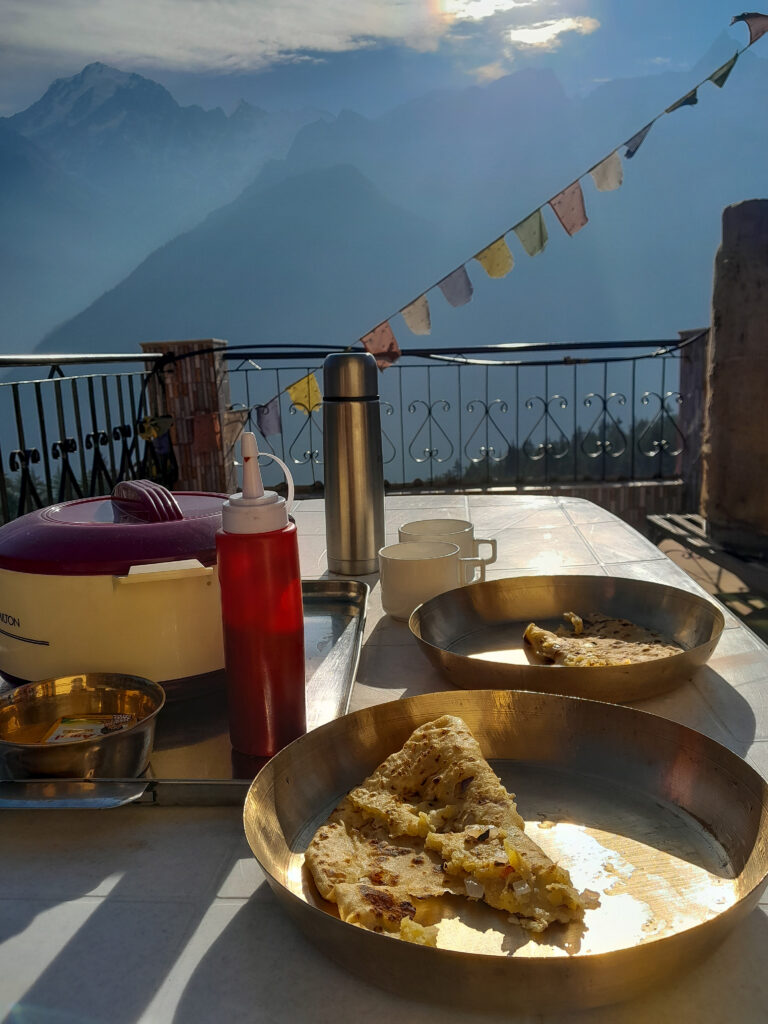
Mr. Negi and his sister prepared the food for us. They served us healthy local cuisine with a variety of vegetables, mushrooms, dals, buttermilk curry, rajma, parathas, milk & egg, rice and wheat chapati. As soon as the sunlight slithered into our room through the windowpane, the brother-sister duo would knock on the door and offer us breakfast with a smile. We would set up a table on the terrace and delight in the meal with a view of the trees and mountain. A black bird occasionally would come and sit on a leafless tree and sing its melancholy song. I do not know what it was pining for but its sound waves collided with the bleating of a sheep from the neighbour’s house. The resulting wave created a soothing sad melody.
We received such a homely hospitality that during our stay with them we never felt like strangers. What contributed to creating that feeling of ease, contentment and belonging that made this place feel like home even when we had never spent time in it before? This is the sentiment that reflects in the Kinnauri culture. It is here that I realised that it is not necessary that home is where one belongs but home is also where one can be at ease.
KALPA THROUGH OUR LENS
Kalpa is a small village located at 9700 feet above Reckong Peo, the district head of Kinnaur region. It is mainly inhabited by the local Kinnauri people where Hinduism and Buddhism coexist in harmony.
Chiselled out of green valleys and orchards, snow covered mountains and gushing streams, it is mainly known for its production of green and golden apples, apricots and Chilgoza trees. The locals are dressed typically in a blend of both Kinnauri and Tibetan culture with the majority of them wearing the traditional Kinnauri hat, locally known as Tepang.
Through our photographs we share with you our experiences, places we visited and things we did while in Kalpa.
THE LONG WALK ON A DEADLY ROAD
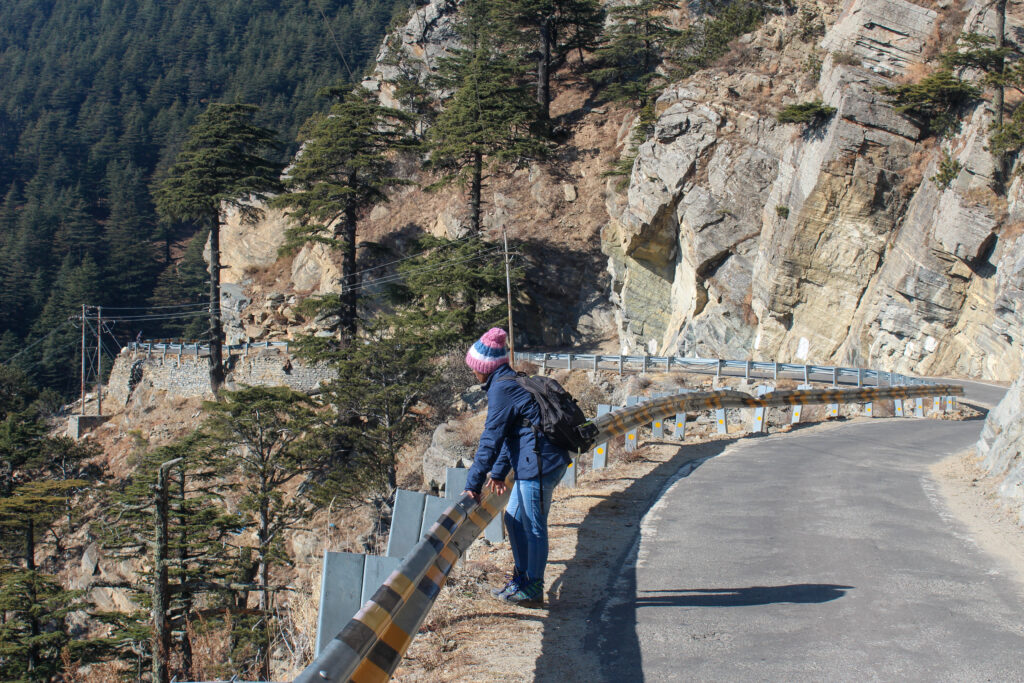
The long walk to Roghi village is worth taking if you love walking. The overhanging cliffs and deep gorge will surely take your breath away. The cold wind emerging from the deodar and oak forests in the foothills hums its whooping song pushing the mist up the rocky heights of the cliffs. The road to Roghi is considered as one of the dangerous mountain roads to drive with threatening edges and vertical slopes. Earlier the road was without any railings making it more risky to drive. But now they give a sense of protection to the drivers. But in a few places a landslide had thrown some of them apart.
A part of this road stretch is named as ‘Rolla Cliff’, famously known as Suicide Point where tourists halt to take selfies and enjoy the view. It is too early to commit suicide, I thought, and moved on.
But we enjoyed this walk at an elevation of over 9000 feet with a breathtaking view of snow-clad mountains and Sutlej river slithering in the deep valley below. Up above the cliff the jungle crows chased a hawk away. Except for a couple of locals whom we met, the road with curves and lanes was entirely ours alone. We ran, laughed and danced like a madman who finds pleasure in losing himself. We went really slow, waited at every turn and engulfed the beauty in it. Along the road we saw gigantic deodar trees and the fresh smell of pines soothed our senses.

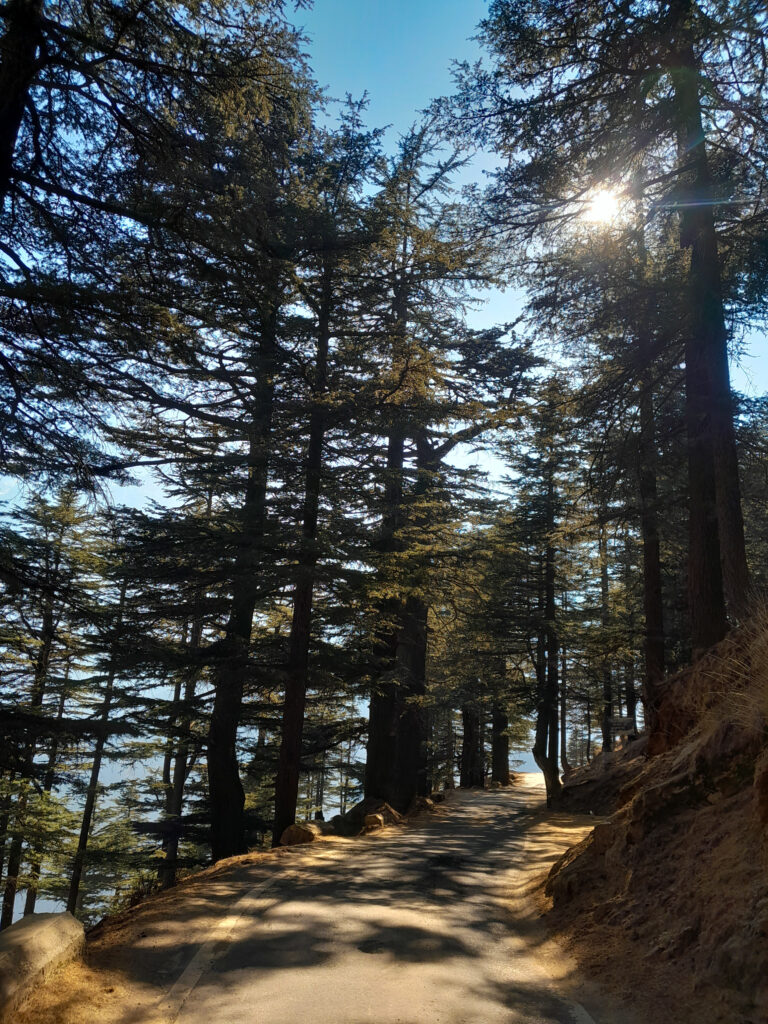
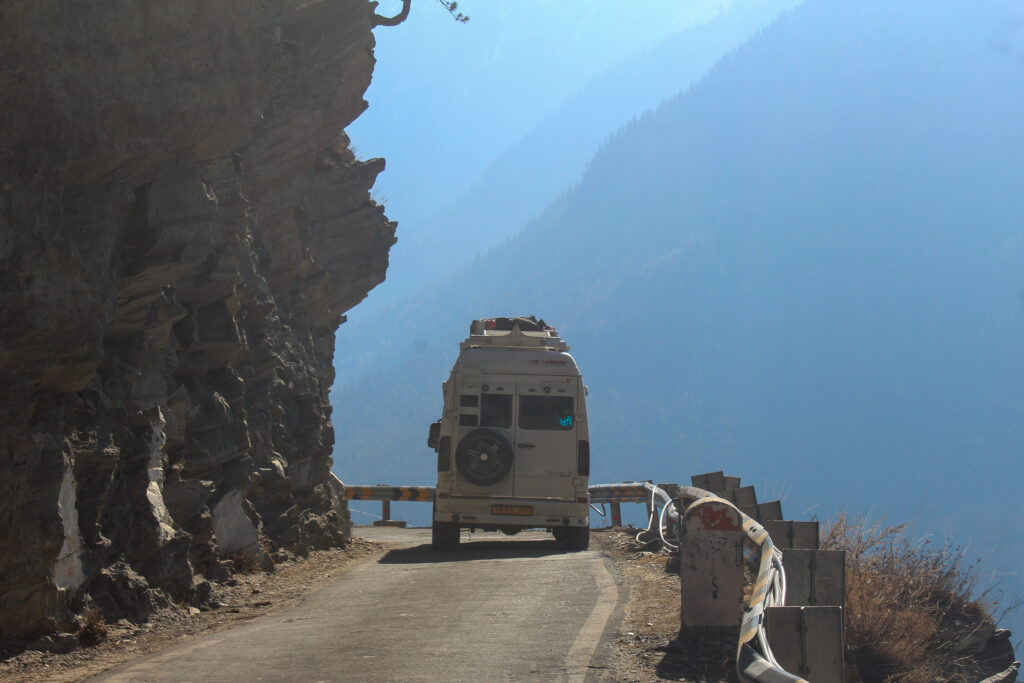
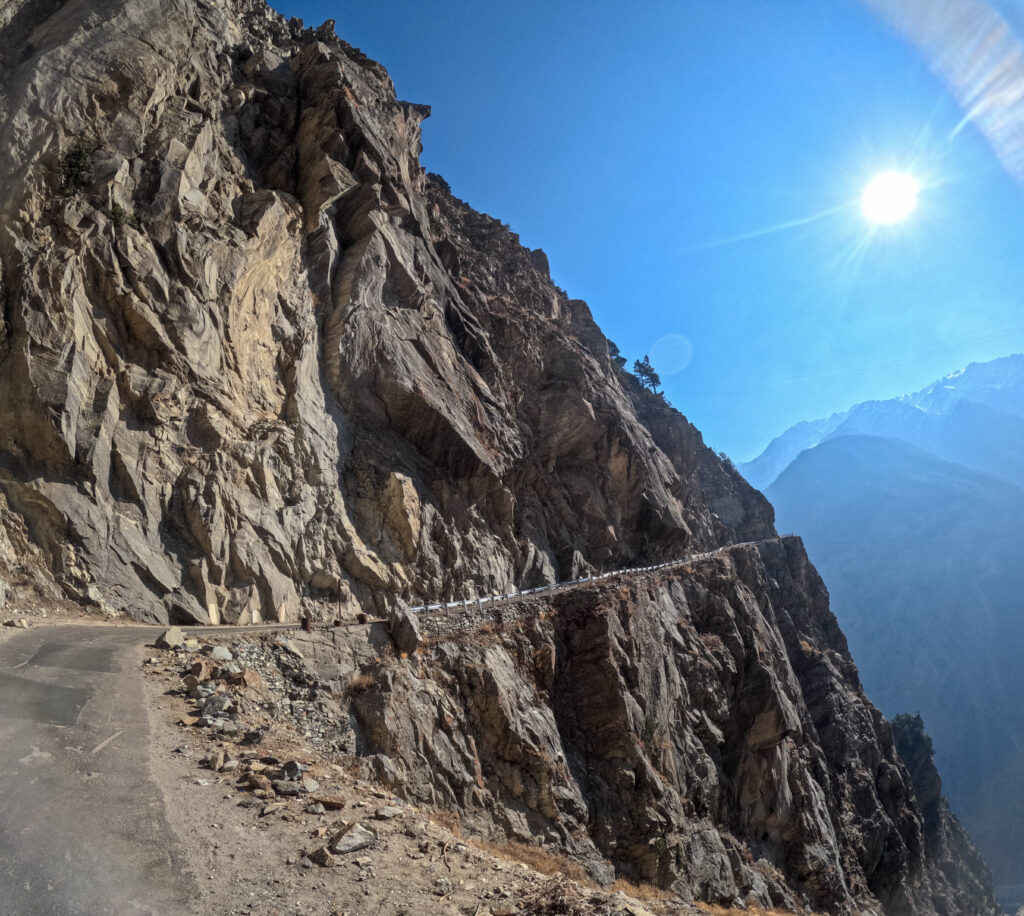
ROGHI VILLAGE- WHERE TIME IS FORGOTTEN
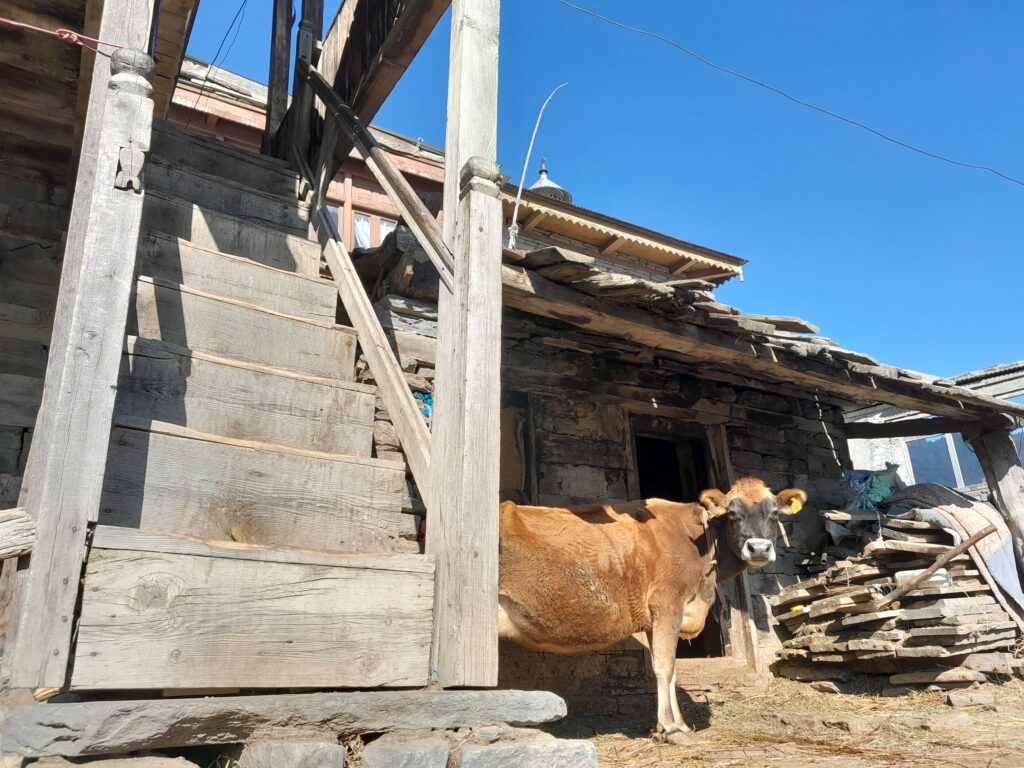
If Kalpa is emerging as a quaint and peaceful tourist destination, Roghi village is known for its rustic and ethnic village life with traditionally stone built houses and terraced apple orchards. The houses here look like they are clinging to the mountainside. There are no eateries, hotels or accommodations of any kind in Roghi but the people here are warm and welcoming. This sleepy village has a very small population.
As we reached the village, there was no one to be seen except for two elderly men smoking cigars on a bench. One of them got up and sensing our curiosity guided us towards the 500 year old Narayana temple that faces the snowy peaks of the Himalayas. Narayana temple is a wooden architectural marvel in Kinnauri style in the lanes of Roghi. The handmade artworks are amazing with carvings of different Gods and Goddesses and animals. Very subtle and excellent artwork.
We walked the lanes and took photographs of the old wooden houses. Although standing for years, they still looked very raw and rugged. The architectural beauty of the houses adorned with intricate carvings was quite admirable. An old man with a sack of woods loaded on his back walked down the stone steps prudently. A girl catching a hand of a small boy ran merrily in the lanes. The boy was shy and hid his face from us. Few women were collecting timber and fodder for their own sustenance and that of their livestock like sheep and goats.
Life was very slow paced at Roghi. For the few hours we spent here, we were completely at peace and unwind from the materialistic world. The village offered us a glimpse into the local way of life of the traditional Kinnauri culture.

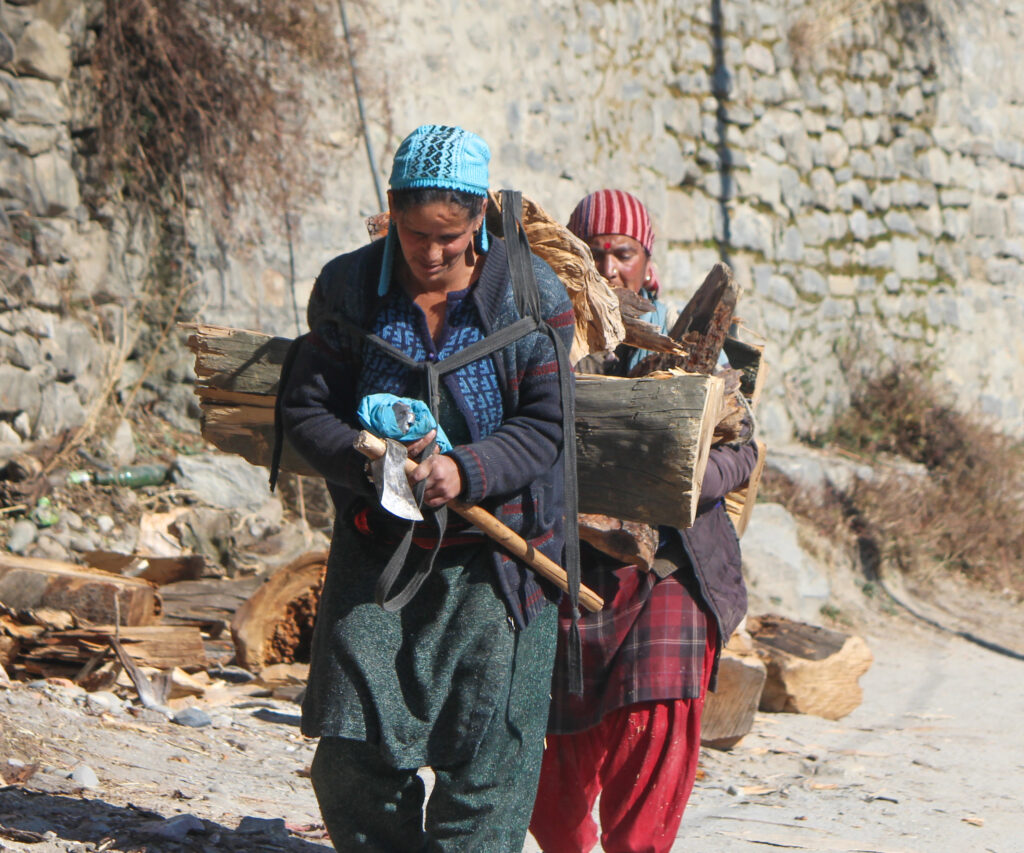
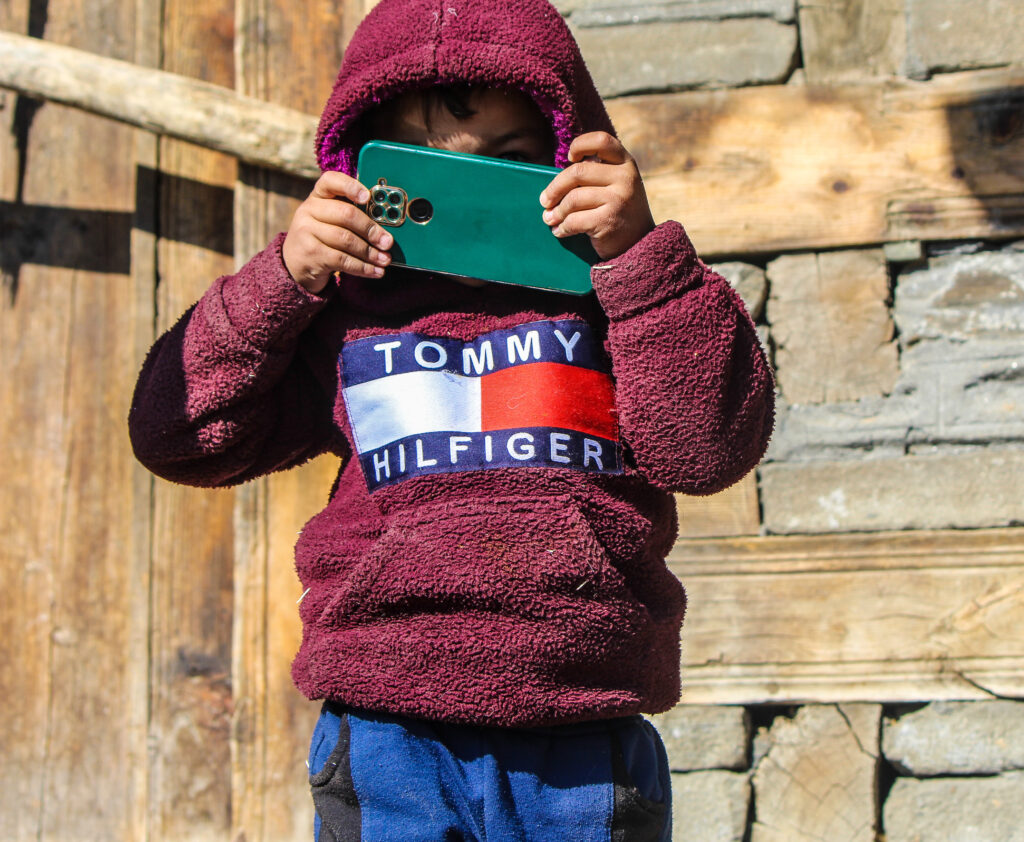
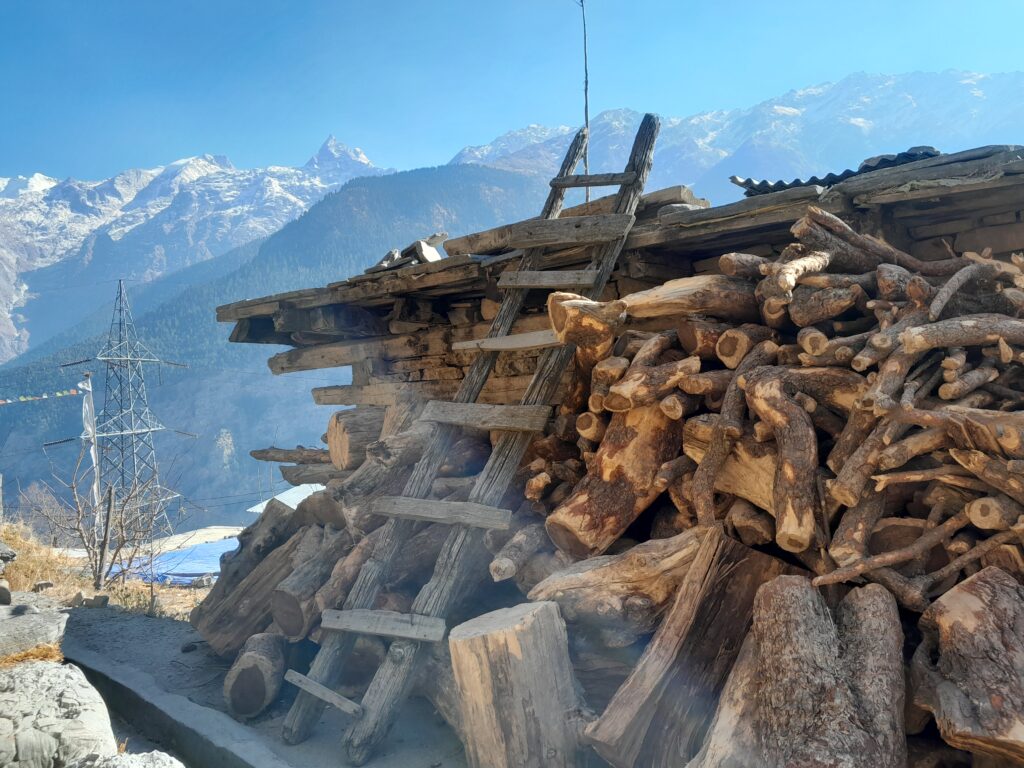
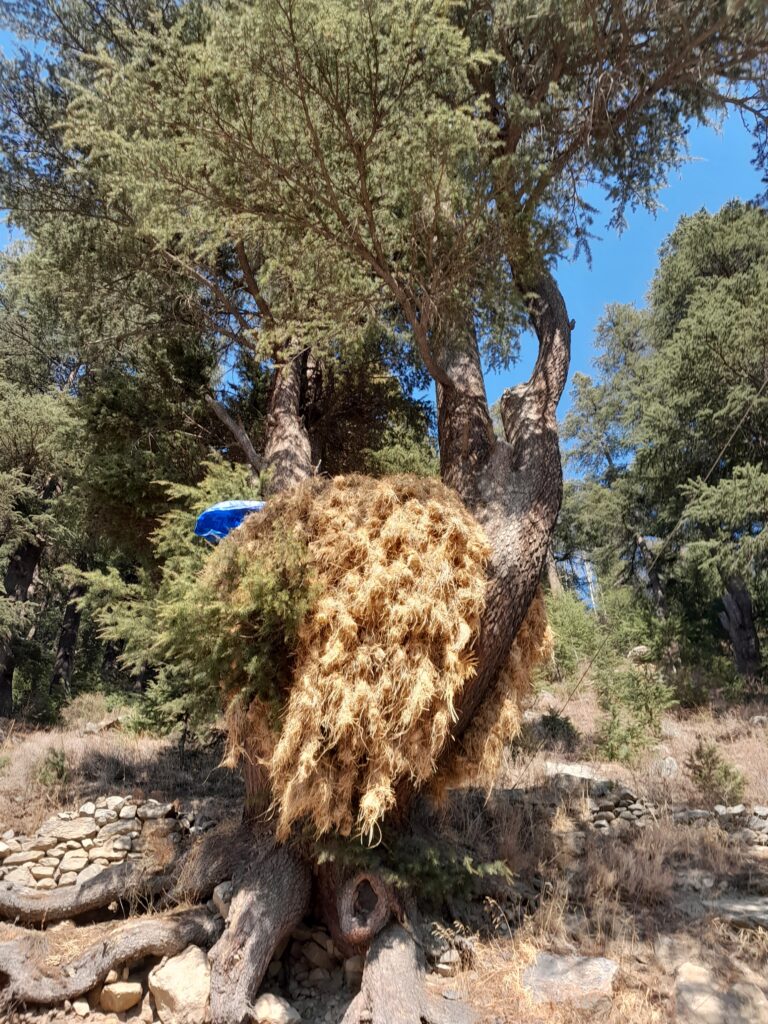
TRADITIONAL HOUSES- NOSTALGIA IN EVERY CORNER
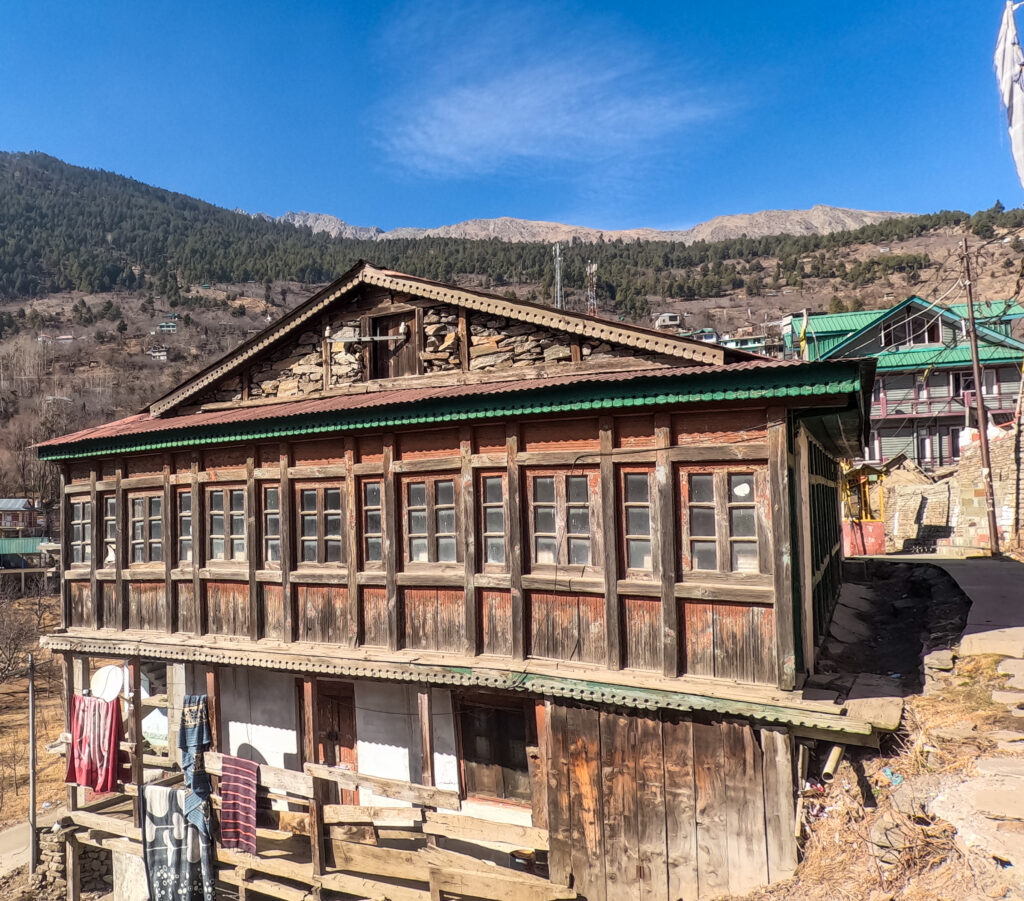
Though the village still has many traditional houses, modern concrete houses are replacing the traditional architecture. A traditional pahari house in Kath Kuni style is built using materials like timber wood (deodar), stone and mud. Stone and wood walls are built by stacking alternate layers of wooden beams and stones. The air trapped between stones and wood keeps the interiors warm during the cold winter. Some houses have a sloping roof made of slate stone tiles. Slate tiles are frost resistant and prevent strong winds from dislodging the roof. The roofs have proper slopes for efficient drainage, in heavy rainfall and snowfall. Major occupation being agriculture, the house consists of many stores built for storage of grains.
We would stand, admire and appreciate the simplicity and beauty of these old and vernacular houses. They looked so beautiful amongst the slopes facing the mountains.

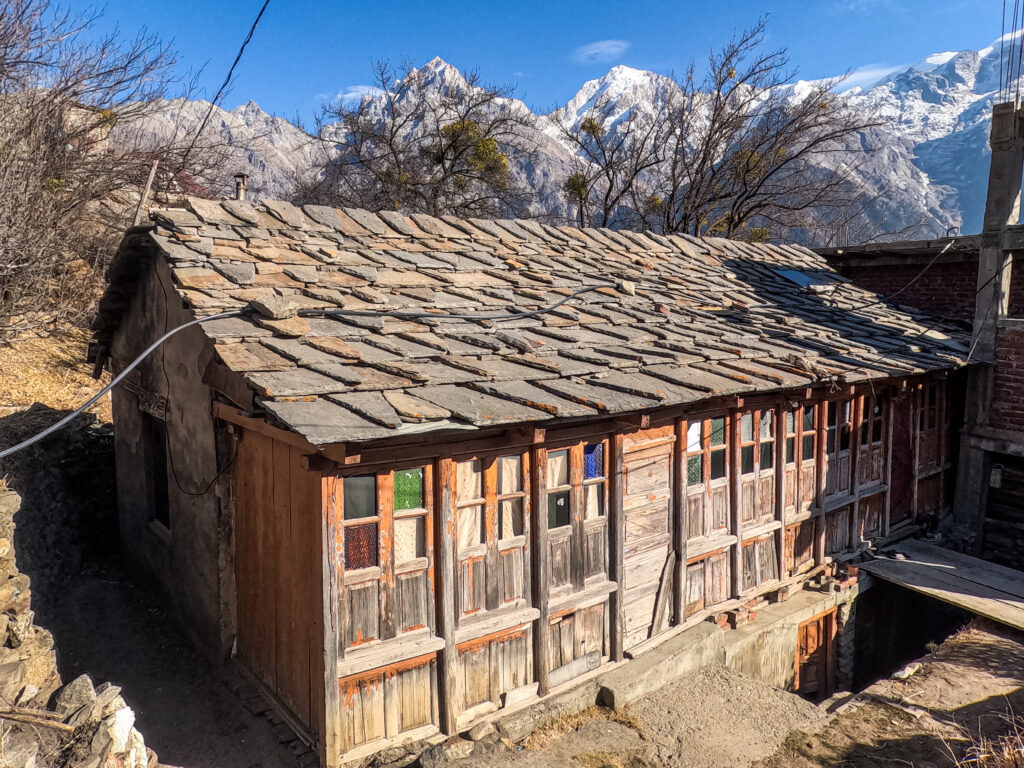
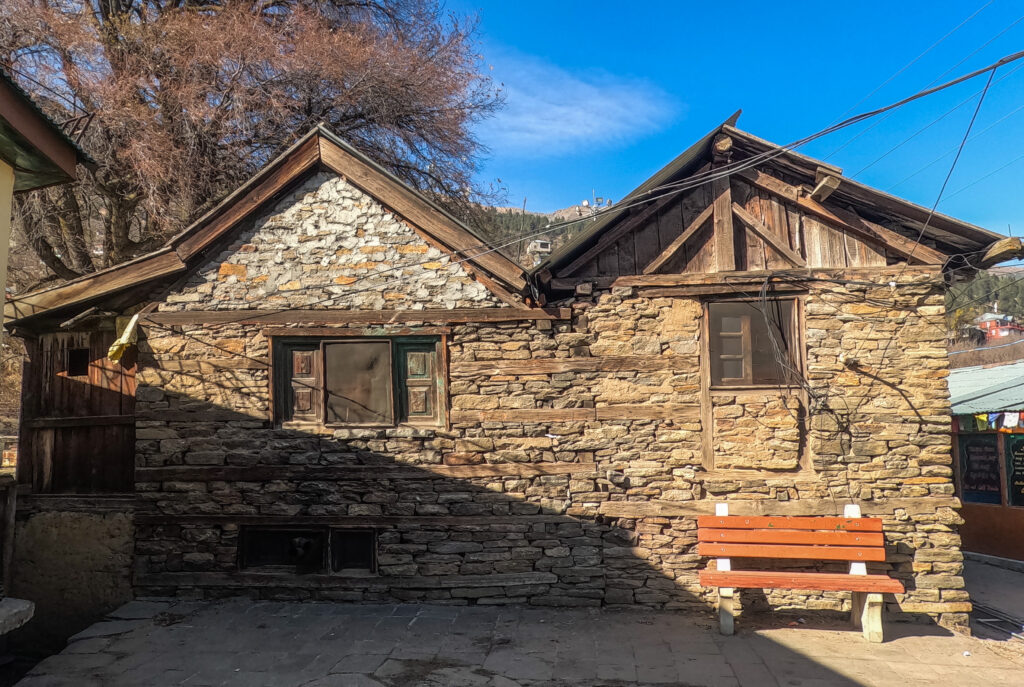
EMBRACING THE CHILL WITH THE ‘BUKHARI’

As winter engulfs Kalpa, the residents turn back to the traditional fuel wood heating system with the ‘bukhari’. To live through the cold days ahead, loads of wood are already stocked up. Every house has a bukhari installed for the winters. Mr. Negi informs me that during extreme cold or when the snowfall is heavy the bukhari takes the centre stage and most of the household activities are held in the room where the bukhari is installed.
He showed us the room where the Bukhari, also known as tandoor, was set up. The base consisted of a fire-chamber in which wood, charcoal or other fuel was burned and a narrow cylinder on the top heated the room and acted as a chimney.
Though we did not get an opportunity to experience the warmth of the room generated by the bukhari but at every morning and dusk we could see the smoke emanating from the chimney of every household. The winter had already set in but everyone waited and gossiped about just one thing – the snowfall. The change in the rainfall and snowfall pattern for the last few years has been the talk of the town.
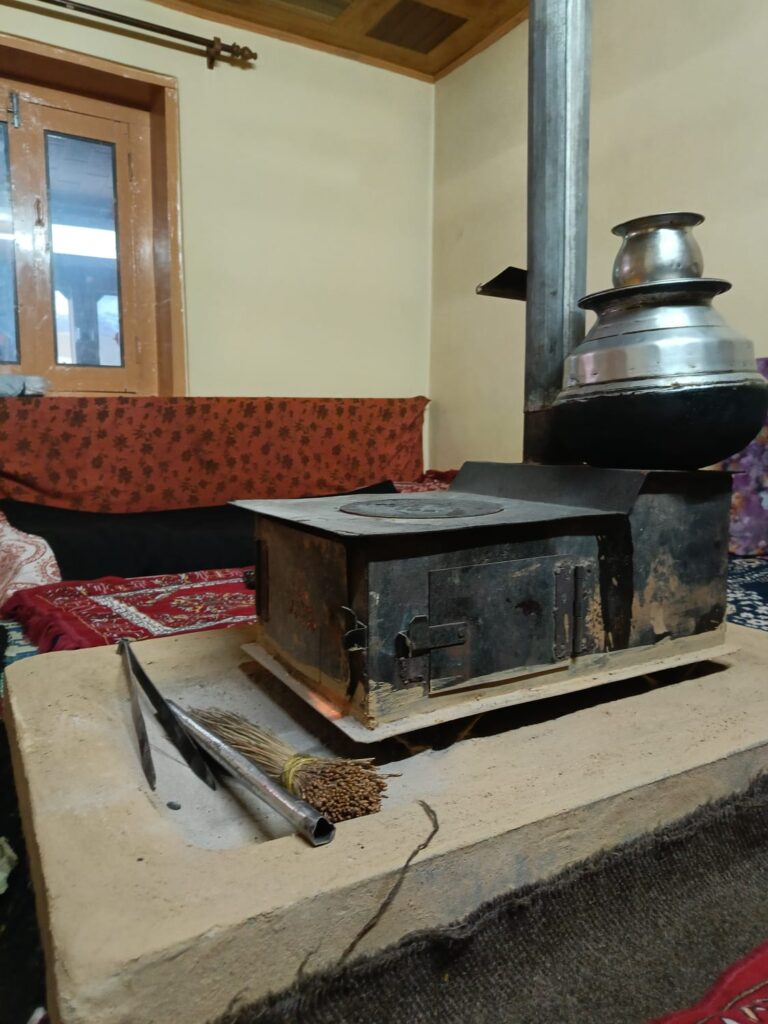

WOMEN AT WORK – THE REAL BEAUTY
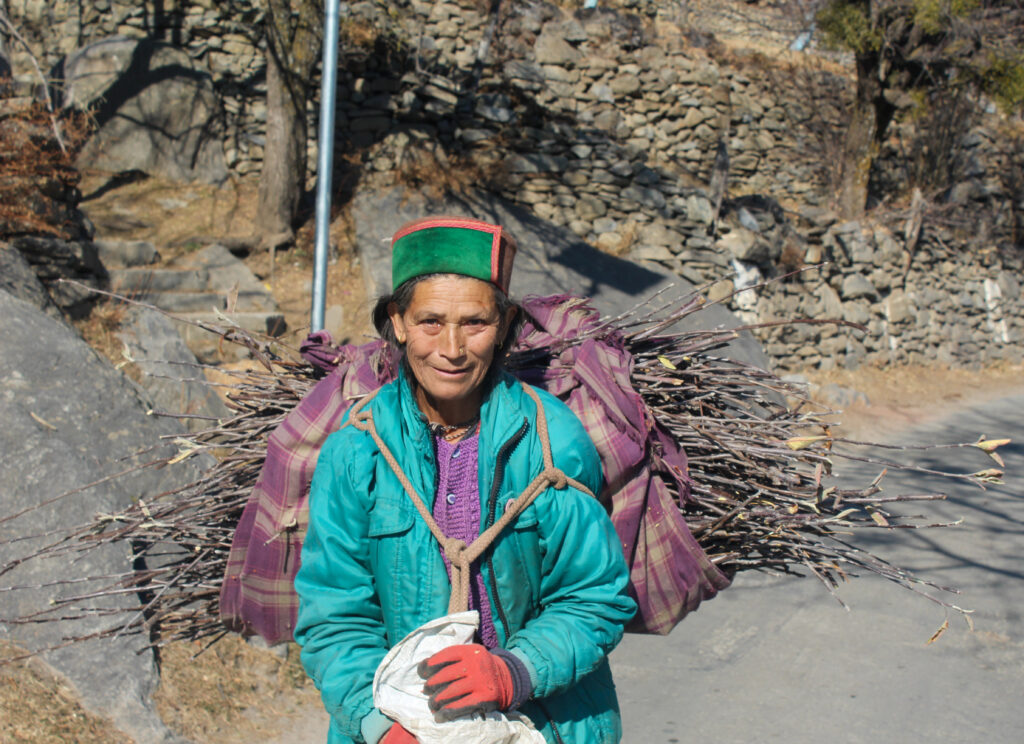
We met this Kinnauri woman while on a walk to Roghi village which is 5 kms from Kalpa. She was collecting twigs of apple trees to feed her cattles. Carrying a smile on her face she welcomed us upon our approach to her. We had missed the way and needed help. She humbly guided us along the path to Roghi and also showed us the distant peak of Kinner Kailash. We spoke about her daily chores and about snowfall and she was concerned about Kalpa not receiving snow till now. So, the wait for snow was everywhere. Among the tourists as well as locals. As the road diverged into two, she bid us goodbye and we waited to see her go. Carrying the load of dry sticks on her back she disappeared with the bend in the road.
Walking through the lanes of houses, we met another woman who was washing the wool to remove the dirt and dust from the fleece. And would prepare blankets from these. But it is a very long process and hard work, she says.
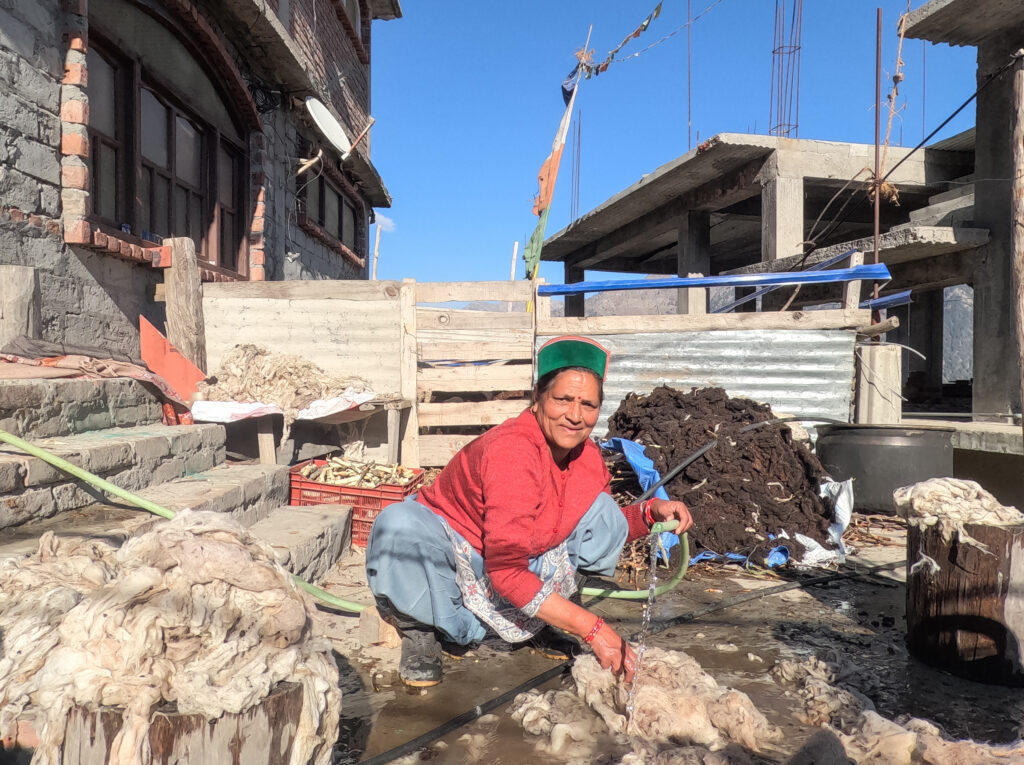
TURNING THE PRAYER WHEELS IN HOBULANGKA BUDDHIST MONASTERY

This is a small ancient monastery located in the narrow lanes of Kalpa. Built in Tibetan architecture style, the carvings on the doors of the temple are extremely beautiful. The monastery has a shrine in the centre and rows of prayer wheels all around. The interior is adorned with vibrant murals, prayer flags, and traditional Tibetan artefacts.
The monastery was founded by the spiritual guru Venerable Rattan Bhadera (Lochowa Rinchen Zangpo) in 958-1055 BC. During his lifetime he constructed 108 monasteries (gompa) and of them is located at Kalpa. The monastery was destroyed by fire in December 1959 but was reconstructed by villagers. The temple was later named as Samdub Choeling.
AN ANCIENT TEMPLE WITH A BEAUTIFUL VIEW
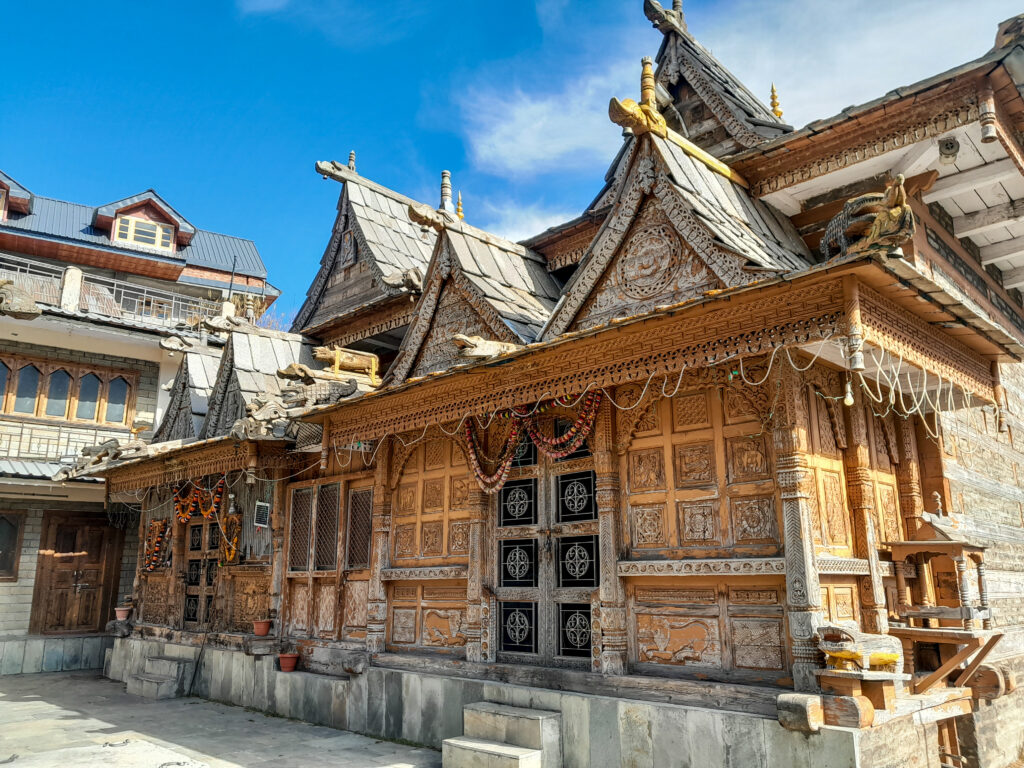
Little ahead of the monastery is a beautiful wooden temple of Narayan Nagini dedicated to Lord Vishnu and Goddess Nagini. The architecture of the temple has intricate carvings and murals adorning the walls and ceilings. The courtyard is spacious with a wonderful view of mountains. The temple is believed to be 5000 years old and as per locals it is mythologically related to Mahabharata.
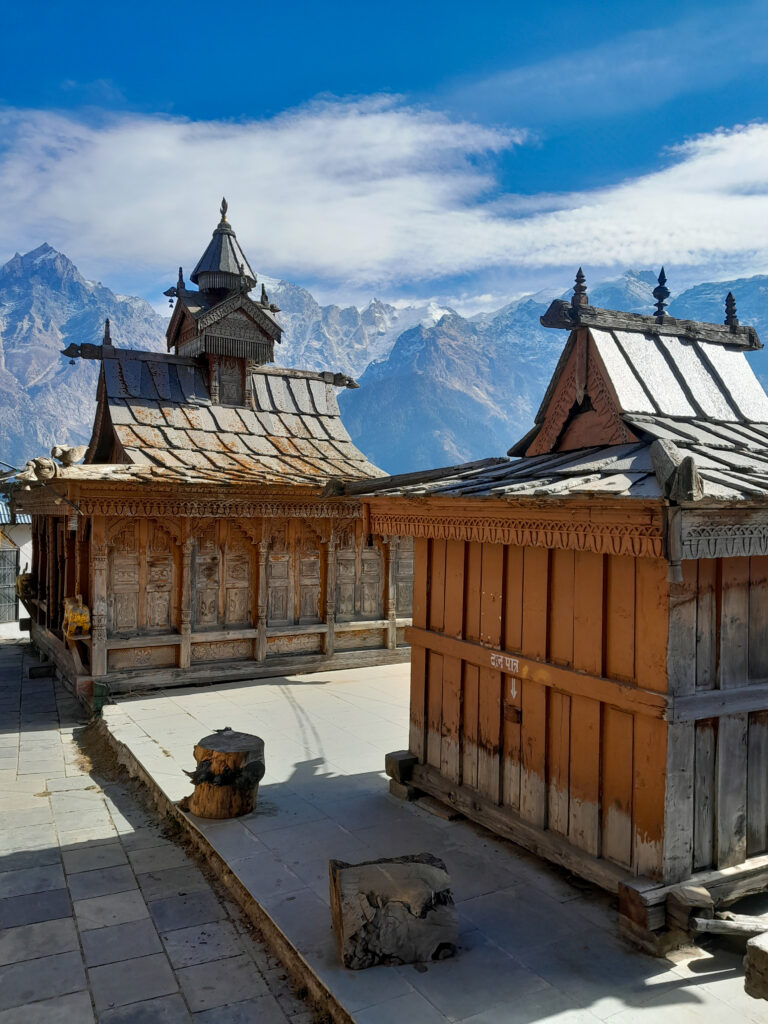
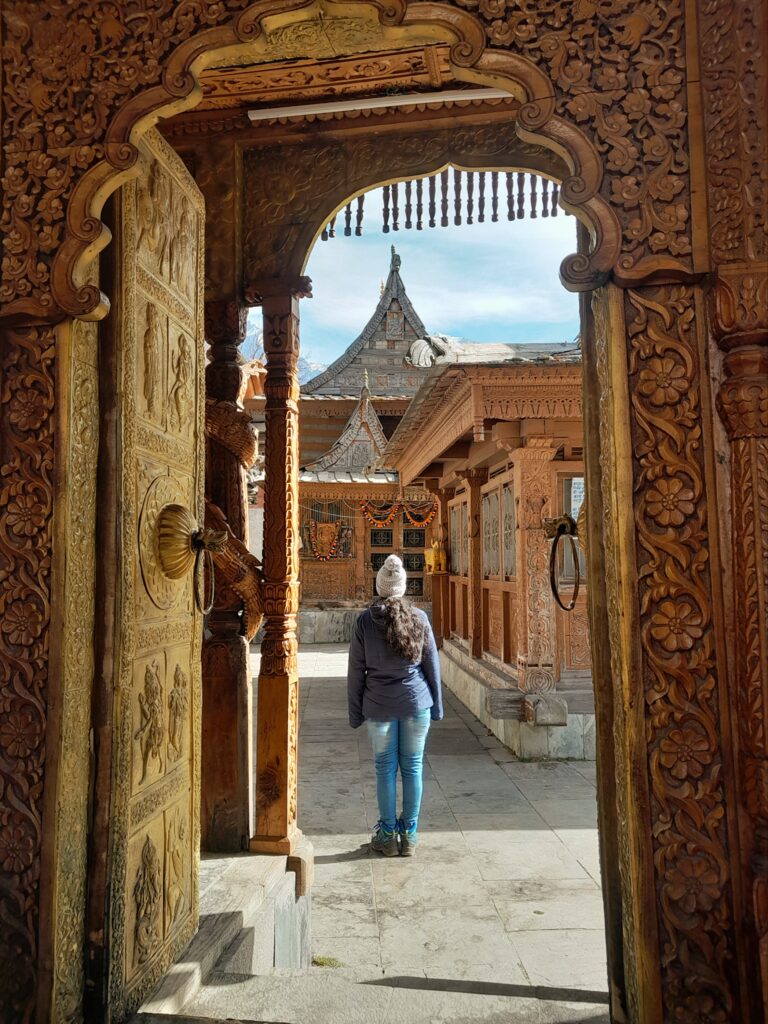
SEEKING BLESSINGS OF THE DIVINE GODDESS AT KOTHI VILLAGE
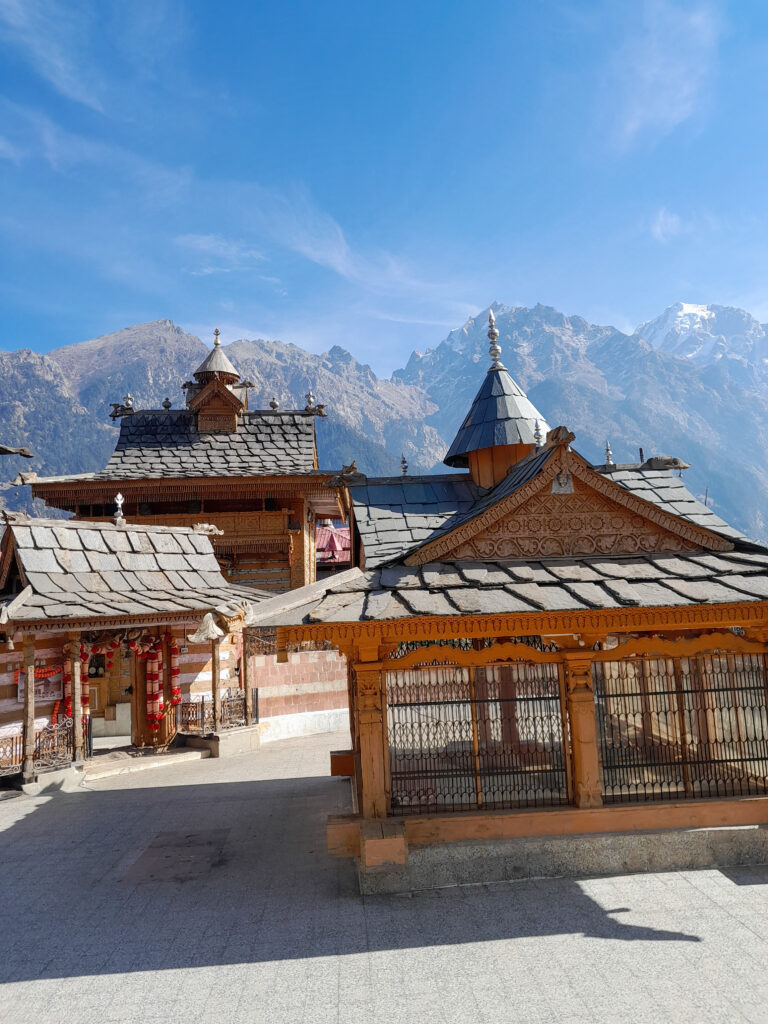
We were on a walking expedition in Kalpa. After having covered Kalpa & Roghi, we decided to walk down the hill till Reckong Peo. Our plan was to do street photography in the market area and capture the colour and vibrance of a new town. After having walked for 3 kms, we stopped to have bananas at a grocery shop near Hospital Mod. The shop owner feels pride in showing us a Chilgozha tree and informing us that it is the only tree to be found in Kinnaur district and nowhere else in India. And it is one of the most expensive dry fruits. He continued to talk and give us information while we relished the not so sweet banana. His next topic was the most trending one ‘The Snowfall’. ‘At this time of the year the place at which you are standing is covered with 2-3 feet of snow’, he exclaims, expressing disappointment at the change in weather.
But he is kind enough to guide us to the ancient Kothi village to take the blessing of Goddess Chandika Devi. Chandika Devi is considered as one of the powerful goddesses and is revered by tourists from across the country who come to seek the blessings from the divine. The local people hold the goddess in great reverence.
Made of wood and stones the temple has a beautiful architecture which looks unique with a shikhara made of slate stone. The main attraction of the temple is the huge chariot of the goddess which remains inside the temple. The temple priest applies tilak on our forehead and gives us ‘chunari’. It is not just a piece of cloth but chunari is treated with a lot of respect as it is believed that Chunari makes for a great blessing for the devotees of the Goddess.
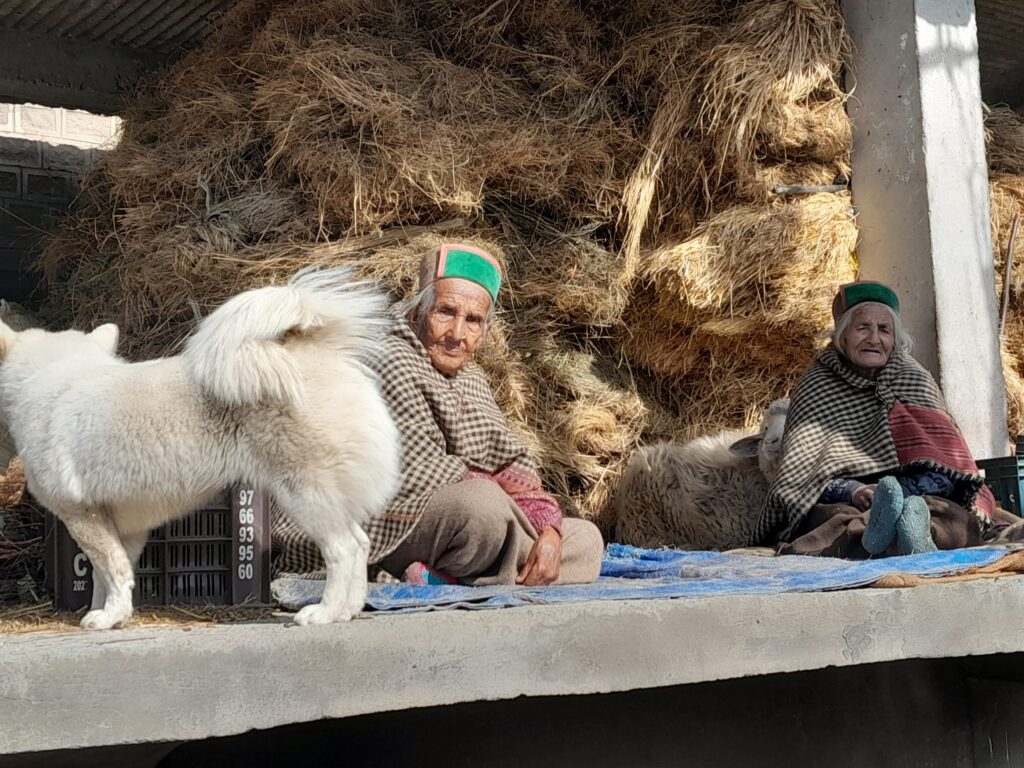
THE FROZEN MAGIC OF WINTER
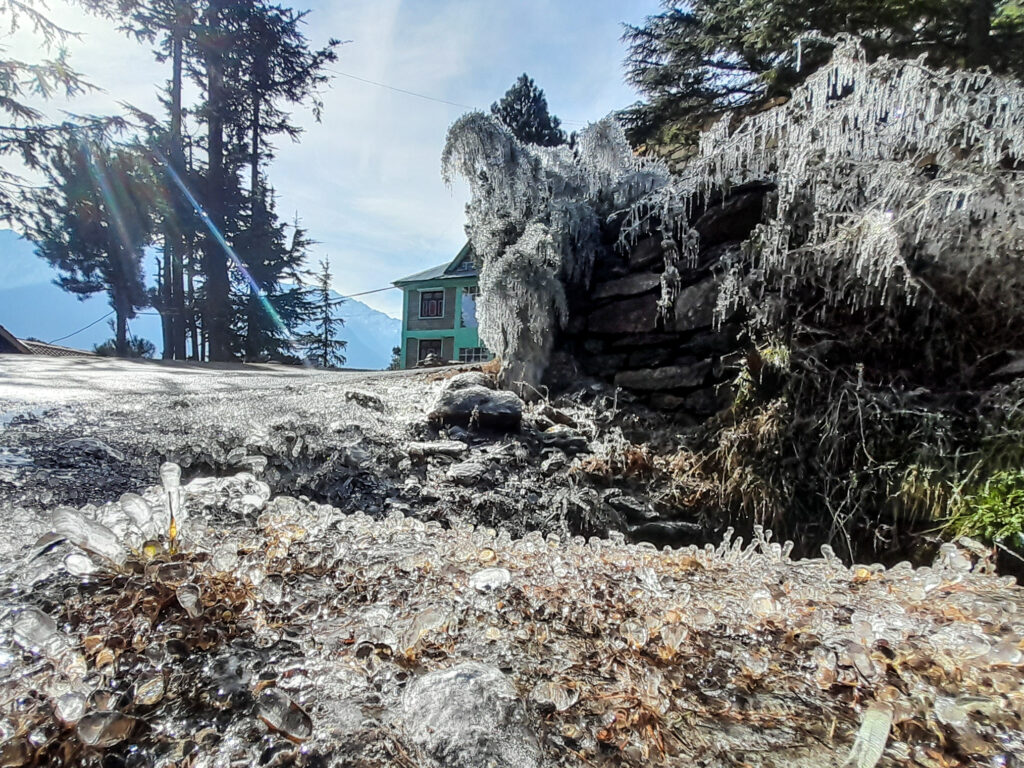
To go to the main Kalpa market from our homestay we always used the pathway from where the glacial stream ran downhill through the farms and houses.

A passage for glacial water is created where it flows down from the Chakka meadows and meets the Sutlej river in the valley below. The water that melts from the glacier is distributed through an irrigation system for agriculture. This meltwater is used for crop irrigation and provides farmers with sufficient water in periods of drought.
The water had already started freezing in many places. On one such walk we saw a small roadside tree frozen with ice. An overhanging water pipe had leaked water on it coating every inch of the tree forming white icicles.
LAST TWO DAYS OF HOPE
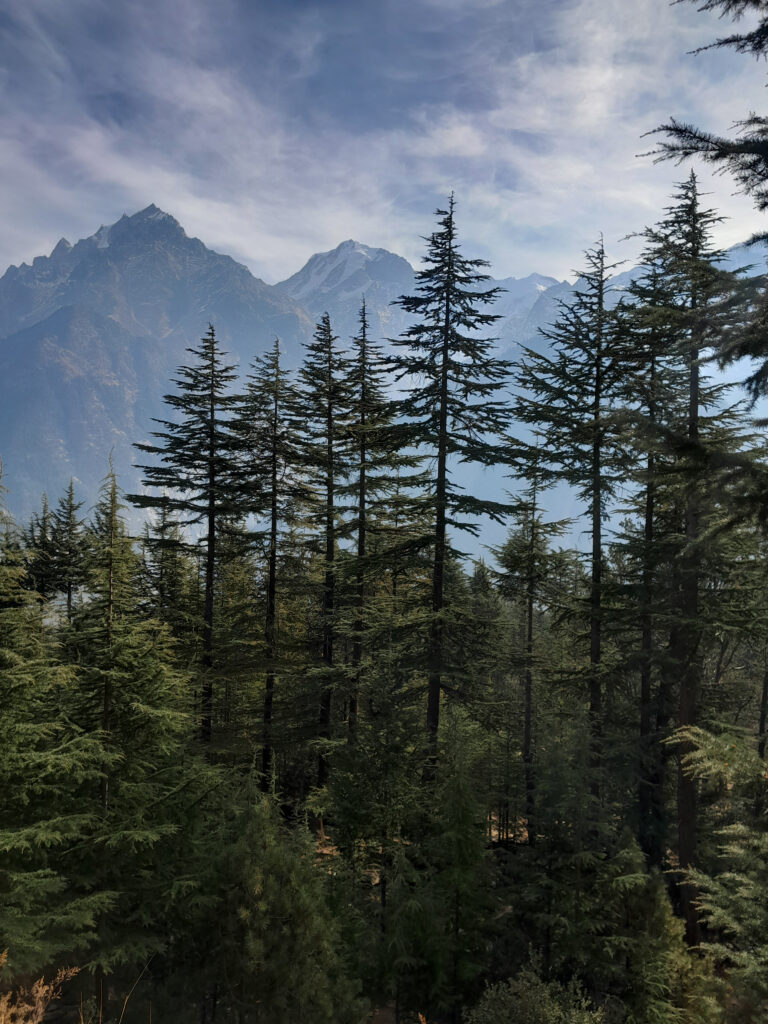
Thodi si raat beeti, Thodi si reh gayi Khamosh rut na jane, Kya baat keh gayi
It had been five days since we reached Kalpa. And each day we would get up in hope of snowfall. The first thing we would do is slightly open the curtain of the window to see if it snowed in the night. But the sky remained clear and a cloud of gloominess hung over us.
We still had two days left in Kalpa. Will it snow or not? Will we have to wait for another year to see snowfall? Three winter trips to North India without witnessing snowfall was saddening us. I stood at the terrace and gazed at the snow-clad mountains and wished the wind would bring the snow clouds.
Lufy looked at me from down with his head slightly tilted, one ear up and other down. I called out to him and wagging his tail he came running towards the door. And that brought happiness. Our few days of friendship had created a bond enough to make good memories.
Forgetting our dismay we spent two days of quality time in and around the homestay with Lufy and Tufy. We engaged in reading a book, writing notes, playing chess, talking to locals, going for a walk amidst deodar trees, cuddling a sheep, feeding the cows, watching the crimson sun spread its golden light on the snowy peaks, and soaking in our own solitude.
‘Listen to the Mountains’ by Pamela Chatterjee is the book which I found myself lost when the author connected me to the daily lives of the people in the mountains. I was able to relate a few things from the book from our current experiences in the Kinnaur region.
It is hard to go when you start loving a place, it’s people and all the things you touch and feel. It happens in travel that when you think that you are learning to adapt to the living of a new place, it is time to leave. To leave with happy memories and in the hope of coming back some day.
Kalpa is etched in our memories, like a fallen snow on a deodar tree. Frozen in time, lost in eternity.
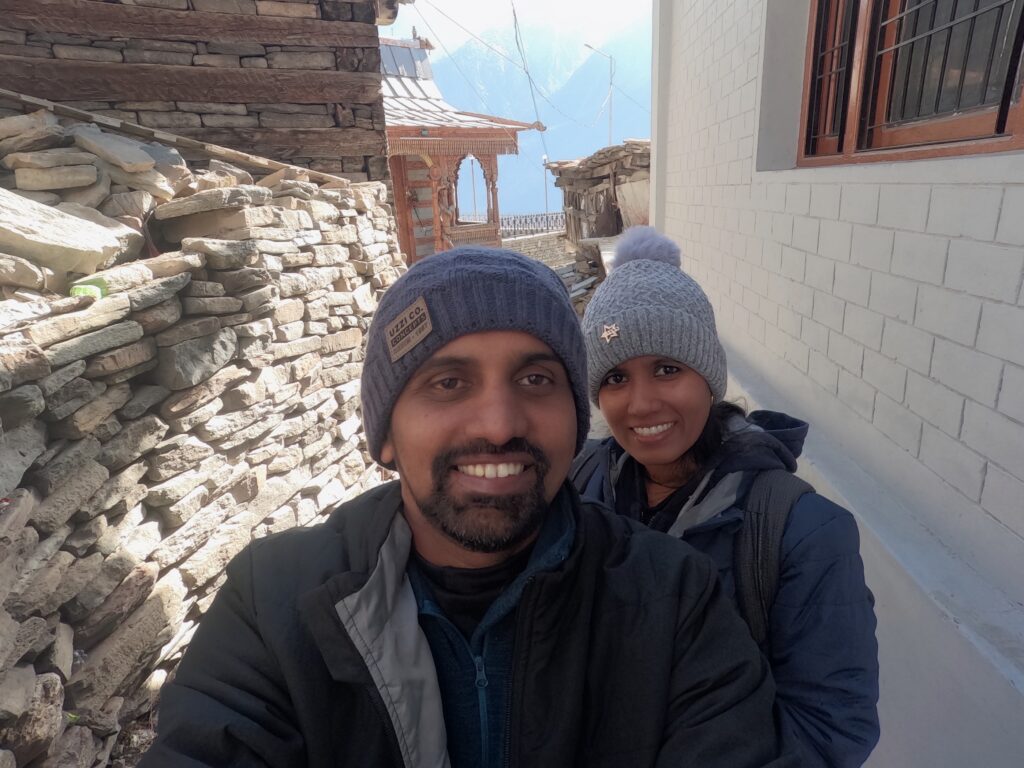
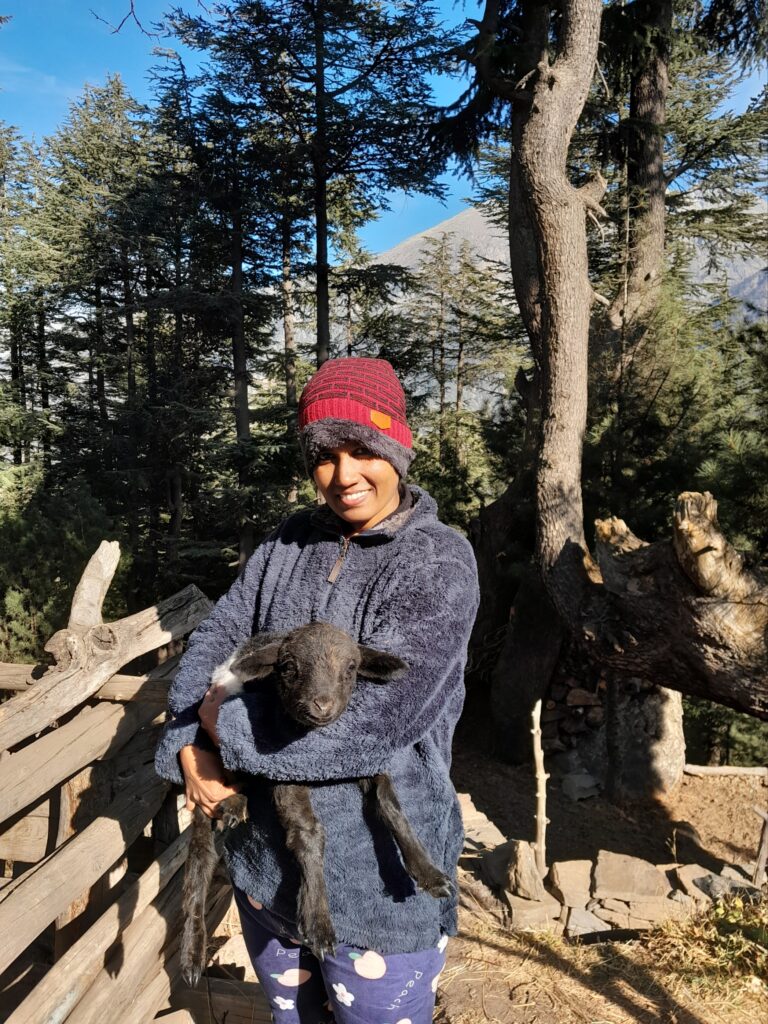
NOTE – Please feel free to comment if you have any questions about the place, how to reach, where to stay, etc. We will be happy to guide you.
You can also email us at roamingwithroads@gmail.com
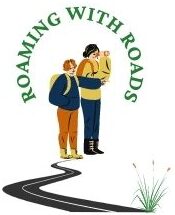
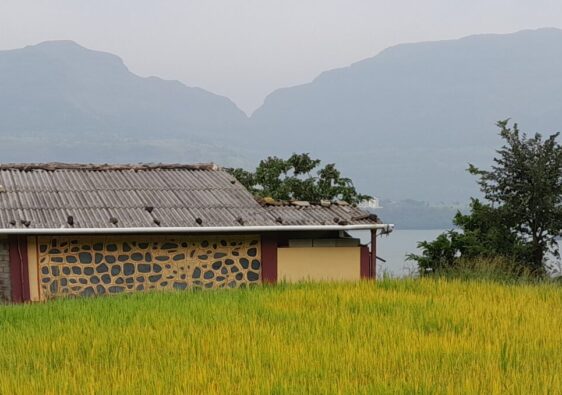
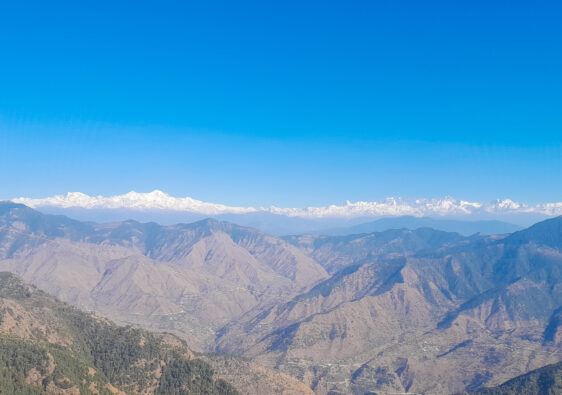
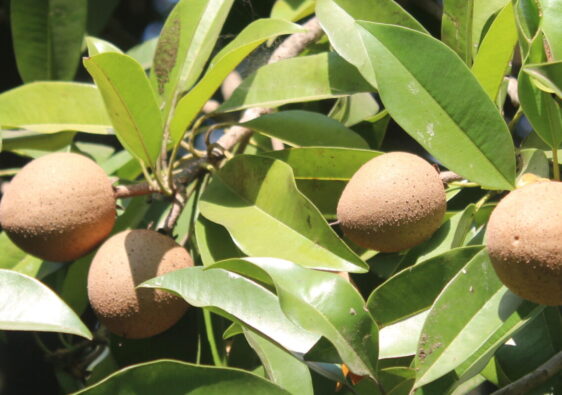
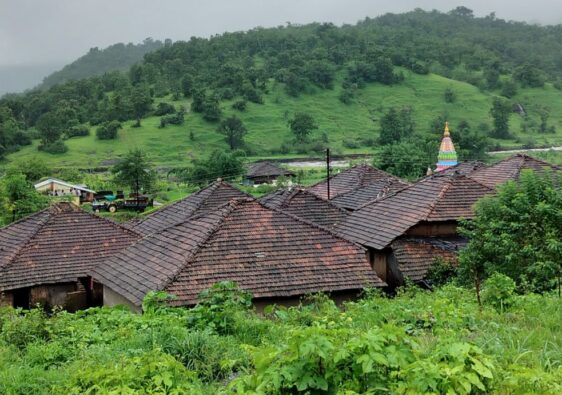
Awesomely described each and every part of the journey
Thank you Neha, we are glad you liked it.
What a captivating account of your trip to Kalpa in the Kinnaur Valley! Your detailed description and stunning photos truly bring the beauty of the region to life. It’s amazing to see how much there is to explore in Himachal Pradesh. For anyone looking to plan their own adventure in this beautiful area, check out Kinnaur Tours for some fantastic travel packages and tips. Thanks for sharing your experience!
Thank you Rishabh
Superb……..Keep Travelling
Thank you so much